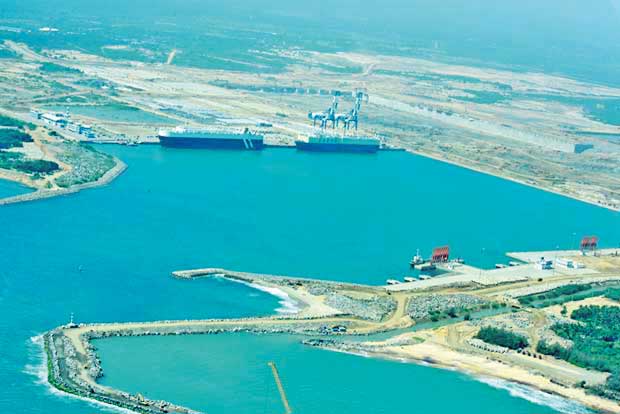Reply To:
Name - Reply Comment
Last Updated : 2024-04-25 14:54:00

During the last decade, China has heavily invested in ports across the world. In South Asia, they built the Gwadar Port in Pakistan and the Hambantota Port in Sri Lanka. China has been a forthcoming and non-interfering alternative to funding from international financial institutions and Western donors. They have the excess capital and the capacity to take high risks, and they financed the construction of the Hambantota port at a time when no other country or development partner was willing to invest in it. Now a Chinese company has come forward to further invest in the Hambantota port to develop it rather than let it squander its immense potential while generations of Sri Lankans serve the debts on a non-performing port. From an international relations point of view, China also serves as a counter-balance against the regional hegemony of India and other influences on our land.
the Hambantota port at a time when no other country or development partner was willing to invest in it. Now a Chinese company has come forward to further invest in the Hambantota port to develop it rather than let it squander its immense potential while generations of Sri Lankans serve the debts on a non-performing port. From an international relations point of view, China also serves as a counter-balance against the regional hegemony of India and other influences on our land.
Therefore, rather than solely criticize China for their opportunistic investments, it is important to recognize that, it is our governments that have voluntarily and actively sought these investments and exercised their (our) will when they reached out to China to fund a massive port project among other infrastructure projects.
Since the turn of the century, China’s exponential growth and increasing influence in many regions spanning Australia to South America have attracted the attention of the world. China has not spared South Asia in its unquenchable thirst for resources, search for strategic locations, and reach for emerging markets.
According to the Heritage Foundation’s China Global Investment Tracker, from 2005 to 2014 China spent US$ 870.4 billion in worldwide investments and contracts, out of which US$ 8.9 billion was invested in Sri Lanka. In contrast, according to the International Finance Corporation (IFC), which is part of the World Bank group has made cumulative investments worth US$ 596 million in Sri Lanka.
Even though Chinese investments here are a smaller fraction compared to their global investments elsewhere, taken in context and compared to other global investors, these are considerable figures, and China’s investments in infrastructure are prominent.
Chinese investments, grants, and trade are all intricately interlinked. In Sri Lanka, China is the biggest source of FDI pumping in more than US$ 400 million in 2014. China has been involved in projects such as the Norochcholai Coal Power Plant, Mattala Airport, Colombo-Katunayake Expressway, Moragahakanda Project, and the Southern Expressway.
As the largest donor since 2009, China extended US$ 1.2 billion worth of assistance in the form of grants, loans, and credit amounting to 54% of the total US$ 2.2 billion committed by foreign countries and multilateral agencies. China provided Sri Lanka US$ 5 billion in aid over the last decade. Some of China’s lavish gifts include the BMICH, the Superior Courts complex, and the Lotus Pond (Nelum Pokuna) Performing Arts Theatre. China also fulfilled 65% of its total pledged assistance to us.
China surpassed the United States as our second-largest trading partner behind India in 2013. In the same year, Sri Lanka’s bilateral trade with China exceeded US$3 billion. All these growing aid packages, trade relations, and investments indicate China’s increasing involvement with us and its lasting footprint in the region.
"From an international relations point of view, China also serves as a counter-balance against the regional hegemony of India and other influences on our land"
Foreign policy analysts have explained China’s expansion in South Asia with diverse arguments. The “string of pearls” theory examines the intention of China in building commercial and potential naval bases along the Indian Ocean region, including countries encircling India.
Earlier this year, China turned the string of pearls theory propounded by the west on its head with the launch of One Belt One Road (OBOR) initiative. With OBOR, China is building infrastructure connecting China, Asia, Europe, and Africa through ports, highways, railroads, pipelines, power and other networks.
Unlike the multilateral institutions and western countries, which impose conditions based on human rights, democracy, and good governance, when extending development loans, China does not interfere in the internal workings and sovereignty of loan/investment recipient countries.
"China has also emerged as an expert in construction and engineering which has influenced many countries to choose them"
According to former Foreign Secretary Palitha Kohona, the Chinese government believes that low-key communication and mutually beneficial dialogue, carried out on an equal footing is more efficient than the US approach of distributing money and exerting pressure. According to Kohona, “Asians don’t go around teaching each other how to behave…there are ways we deal with each other - perhaps a quiet chat, but not wagging the finger.” His words clearly manifest one of the main reasons why Sri Lanka prefers China as a development partner.
Sri Lanka, becoming a middle-income country in 2012 also precluded concessionary loans and forced the country to find alternative sources of funding. Further, Western countries distanced themselves from Sri Lanka post 2009 based on war crimes allegations. During the tenure of President Mahinda Rajapaksa, Sri Lanka moved away from its traditional funding partners and moved closer to China. Though the present government initially seemed to distance itself from China in 2015, soon it realized that the West does not have the kind of resources that China invests in Sri Lanka, and that China’s tentacles here are too deep. Besides, in the new world order, China is too big a player to take for granted anyway.
Unlike other donors who are reluctant to invest in large-scale, high-risk infrastructure projects, China is ‘forthcoming’. They are willing and able to take long term risks and invest in countries with higher political risk. During a 2010 interview with Singapore’s Straits Times, former President Rajapaksa said, “…take Hambantota Port. It was offered to India first. I was desperate for development work. But ultimately the Chinese agreed to build it.” Several large China-funded infrastructure projects in South Asia are high-risk ventures in which no other multilateral organization or Western donor country wants to be involved in.
China has also emerged as an expert in construction and engineering which has influenced many countries to choose them, particularly for port projects. All these have played a role in Sri Lanka choosing China’s involvement in building port infrastructure.
India has long seen itself as the natural leader in the Indian Ocean region and wants to ensure that its namesake ocean remains India’s Ocean. However, many countries consider that the Indian Ocean is not only India’s backyard but also a region to which both littoral states and outside powers have a claim. With increasingly strong ties with the US and aims to curb China’s expansion in the region, India threatens to become an ever-greater hegemony. Countries such as Pakistan and Sri Lanka are strengthening their ties with China to counter-balance the regional hegemony of India.
China has also been a formidable friend in diverse international fora. In 2012, China was strongly against the US backed UN resolution against our country. Though not openly admitted, when we reached out to China to fund development projects, it is also driven by the fact that closer ties with China would be a way to balance power with India and prevent the influence or interference from other global players.
Chinese investments are also justified as a means to achieve long-term development goals in terms of infrastructure development, employment generation, and trade expansion. One of the main targets at the end of the war was to catch up on thirty years of lost development opportunities. China with its multi-million dollar investments to put in place much-needed infrastructure became a dependable friend. When the Hambantota port project was started, the then government claimed it would bring in prosperity to one of the least developed regions of the country, create job opportunities, and boost the economy.
The recent agreement for Chinese investment in Hambantota is endorsed with expectations of skilled employment generation, regional and national economic development, stabilising the Sri Lankan rupee, and the reduction of national debt percentage. Further, better transport infrastructure would provide better access to regional markets.
There are a number of strategic, political and economic reasons for China to be interested in the Indian Ocean region and South Asia in particular. Though a Chinese naval base here is far-fetched, China is interested in maintaining its presence in the Indian Ocean because of its strategic, economic, and political importance.
As the world’s leading manufacturing hub and the second largest economy, China needs to secure energy and goods supply routes along the Indian Ocean as alternatives to the Malacca strait. Located at the centre of the Indian Ocean, Sri Lanka is ideal for this and to refuel vessels and for crews to rest and recuperate.
Further, these projects provide Chinese companies opportunities to engage in large-scale investments and earn revenue for decades. They provide employment opportunities for Chinese labourers and opportunities for Chinese companies to export machinery used in these projects. They boost China’s soft power strategies by creating a presence and by being a catalyst for development. The growing economy of Sri Lanka also provides a market - albeit small - for China’s manufactured goods.
It is based on all those interests that China is making large-scale investments in maritime infrastructure in Sri Lanka and the region, and they insist that their investments are purely pacific and based on goodwill between long standing friends such as Sri Lanka.
"As the largest donor since 2009, China extended US$ 1.2 billion worth of assistance in the form of grants, loans, and credit"
By nature, infrastructure developments are long-term projects that often take decades to reap their intended benefits. They often require further investment to develop facilities to make these projects profitable. Hambantota port was built as a transshipment and bunkering facility to refuel and provide supplies to the large number of ships that ply the main east-west shipping route. It still requires considerable investments to improve its services and facilities to make it a fully functional port.
If our govt plays its cards right, we will eventually benefit from China’s investments. For that, it is important that our government does what is needed to attract more FDI, develop an export economy, address issues of corruption and deliver on the promised good governance. Irrespective of whatever government is in power, it is also crucial to ensure that Sri Lanka does not become a playground for regional power struggles. Only time would tell whether that is too much to expect from our governments and its servants.
Jmes Perera Tuesday, 22 August 2017 10:23 AM
The Editor,I would have liked to forward this article to a few individuals who criticise this lease, for ulterior motives. But, unfortunately you do not provide. an email link to your articles, like the Sunday Times or the Island, does.
TONY Tuesday, 22 August 2017 11:20 PM
BECAUSE LANKA GOT COMMITTED TO CHINA UNDER MR REGIME

Add comment
Comments will be edited (grammar, spelling and slang) and authorized at the discretion of Daily Mirror online. The website also has the right not to publish selected comments.
Reply To:
Name - Reply Comment
US authorities are currently reviewing the manifest of every cargo aboard MV
On March 26, a couple arriving from Thailand was arrested with 88 live animal
According to villagers from Naula-Moragolla out of 105 families 80 can afford
Is the situation in Sri Lanka so grim that locals harbour hope that they coul